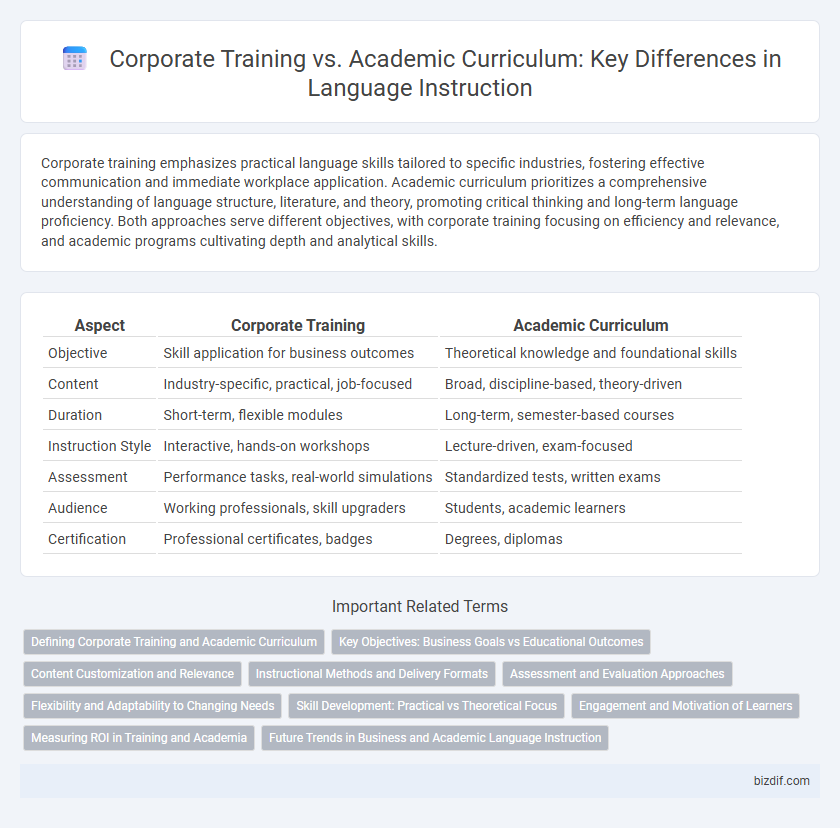Corporate training emphasizes practical language skills tailored to specific industries, fostering effective communication and immediate workplace application. Academic curriculum prioritizes a comprehensive understanding of language structure, literature, and theory, promoting critical thinking and long-term language proficiency. Both approaches serve different objectives, with corporate training focusing on efficiency and relevance, and academic programs cultivating depth and analytical skills.
Table of Comparison
| Aspect | Corporate Training | Academic Curriculum |
|---|---|---|
| Objective | Skill application for business outcomes | Theoretical knowledge and foundational skills |
| Content | Industry-specific, practical, job-focused | Broad, discipline-based, theory-driven |
| Duration | Short-term, flexible modules | Long-term, semester-based courses |
| Instruction Style | Interactive, hands-on workshops | Lecture-driven, exam-focused |
| Assessment | Performance tasks, real-world simulations | Standardized tests, written exams |
| Audience | Working professionals, skill upgraders | Students, academic learners |
| Certification | Professional certificates, badges | Degrees, diplomas |
Defining Corporate Training and Academic Curriculum
Corporate training targets skill development aligned with organizational goals, emphasizing practical, job-specific competencies and immediate application in the workplace. Academic curriculum focuses on comprehensive education, delivering theoretical knowledge across disciplines designed to foster critical thinking and long-term intellectual growth. Defining corporate training involves tailored programs for employee performance enhancement, whereas academic curriculum encompasses structured coursework intended for general academic advancement.
Key Objectives: Business Goals vs Educational Outcomes
Corporate training prioritizes aligning language instruction with specific business goals such as enhancing employee communication skills, improving productivity, and supporting organizational growth. Academic curriculum focuses on educational outcomes including linguistic proficiency, critical thinking, and cultural awareness within a structured learning environment. The key distinction lies in corporate training targeting practical application for workplace efficiency, while academic programs emphasize comprehensive language mastery and theoretical knowledge.
Content Customization and Relevance
Corporate training emphasizes content customization tailored to specific industry needs and organizational goals, ensuring immediate applicability and practical skills development. Academic curriculum often follows standardized frameworks designed to provide foundational knowledge, with less flexibility for industry-specific adjustments. This difference results in corporate training offering highly relevant, real-time solutions, while academic programs focus on broader theoretical understanding.
Instructional Methods and Delivery Formats
Corporate training emphasizes practical, hands-on learning through workshops, simulations, and e-learning platforms designed for rapid skill acquisition, while academic curriculum relies on theoretical instruction, lectures, and standardized assessments to build foundational knowledge. Delivery formats in corporate settings often include blended learning, microlearning modules, and mobile-accessible content tailored for flexible, on-the-job training. Academic programs typically use structured semester schedules with in-person classes and formal examinations to evaluate student performance.
Assessment and Evaluation Approaches
Corporate training emphasizes practical, performance-based assessments that measure skill application and immediate workplace relevance. Academic curricula prioritize standardized testing and theoretical knowledge evaluation to ensure mastery of subject content. Both approaches utilize formative and summative assessments, but corporate training often integrates real-time feedback and adaptive evaluation methods tailored to organizational goals.
Flexibility and Adaptability to Changing Needs
Corporate training offers greater flexibility and adaptability to changing business needs by tailoring language instruction to specific industry jargon and evolving workplace scenarios. Academic curricula often follow rigid structures and standardized content, limiting responsiveness to emerging linguistic trends or immediate professional demands. Customized corporate programs accelerate skill acquisition by focusing on relevant language applications, promoting real-time adjustments aligned with organizational goals.
Skill Development: Practical vs Theoretical Focus
Corporate training prioritizes practical skill development tailored to specific job functions, emphasizing hands-on experience and immediate application in the workplace. Academic curriculum offers a theoretical foundation that builds comprehensive understanding and critical thinking across broader subject areas. This distinction ensures corporate training enhances job readiness, while academic programs foster long-term intellectual growth.
Engagement and Motivation of Learners
Corporate training leverages practical, goal-oriented content tailored to immediate workplace applications, boosting learner engagement and intrinsic motivation through relevance and real-world problem-solving. Academic curriculum often emphasizes theoretical knowledge and standardized assessments, which can lead to lower motivation due to less perceived immediate value. Personalized learning paths and interactive methods in corporate training significantly enhance learner participation and commitment compared to traditional academic settings.
Measuring ROI in Training and Academia
Measuring ROI in corporate training involves analyzing performance improvements, employee productivity, and direct financial gains linked to skill acquisition and application, often using KPIs aligned with business goals. Academic curricula ROI focuses on long-term outcomes such as graduation rates, job placement statistics, and the economic impact of higher education on alumni careers. Both approaches require tailored assessment tools to quantify training effectiveness, but corporate training ROI typically demands quicker, more tangible results compared to the broader, long-term metrics used in academia.
Future Trends in Business and Academic Language Instruction
Future trends in business and academic language instruction emphasize personalized learning powered by AI-driven platforms that adapt to individual proficiency and industry-specific terminology. Corporate training increasingly integrates immersive technologies such as virtual reality to simulate real-world communication scenarios, enhancing practical language skills for global markets. Academic curricula are shifting towards interdisciplinary approaches, combining language instruction with business analytics and digital literacy to prepare students for evolving professional environments.
Corporate training vs Academic curriculum Infographic

 bizdif.com
bizdif.com